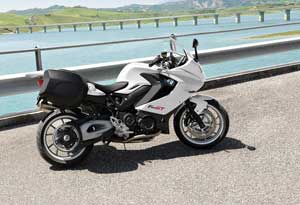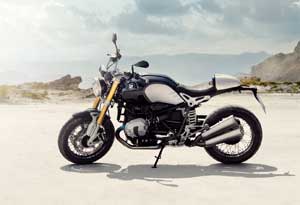| 3 series | 5 series | 6 series | 7 series | Other BMWs | Motorcycles | History galleries | Group photos | BMW and girls | Tests | Links | BimmerinBoard |
BMW F800GT Unencumbered with Excesses
September 17th 2016
Despite GT prefix, this BMW feels far from Gran Turismo, but as quite a compact, lightweight vehicle unencumbered with excessive comfort and sorts of technological bells and whistles as his older tourer brothers R1200RT and K1600GT, the motorcycle.
One thing is when you ride hundreds of kilometers on a straight highway. But it would be much harder to toss such a tourer as K1600GT on middle severity serpentine roads, than a lightweight and fairly short F800GT. Conquering endless turns, slopes and accelerations-decelerations, you especially appreciate a belt drive providing smoothness and continuous rear wheel torque transmission (max 86 Nm) without delays and jerking. Compared with the nervous chain naked F800R equipped with the same engine, the difference is quite noticeable. In addition, the belt is more convenient in journeys because you do not have to lubricate and tighten it. 
BMW F800GT (photo from http://www.rainbow.co.uk/)
Row “double” under wide aerodynamic shrouds provides not outstanding but sufficient dynamics at any gear, so that at speeds above cruising one (~140 km/h) you do not always even have to gear down for overtaking. The most popular three gears out of six: the second-third to ride around the city and the sixth for the highways. There’s a speed indicator on the dashboard – you’ll not be confused where and how much to switch. BMW engineers have found the optimum length of F800GT base: it is compact enough to penetrate across the lanes in traffic jams and generally not to interfere in the city, whereas it is long enough to adhere to a steady course at high speed. This is facilitated by a steering damper offered as the base case. The rigid frame allows fearlessly inclining the bike in corners and keeping it on the straight lines from rearranging on the longitudinal seams and road marking – you do not notice it. 
BMW F800GT (photo from http://www.motortrader.com.my/)

BMW F800GT (photo from http://onlymotorbikes.com/)
While GT fork is not adjustable, its rear shock spring can be clamped by hand, and electronic ESA system allows changing its rebound force: with a button on the steering wheel, you can change mode from Comfort to Normal or Sport. In Comfort mode, suspension logically becomes softer, so that minor irregularities and roughness of the road become less noticeable. In Sport mode, you can feel every stone, but general bike control improves and the behavior of wheels in particular. “Normal” bounce is something in between. I must say that a difference in the behavior of F800GT in different modes is noticeable in direct proportion to the difference in quality of the road surface and change in the road format. If all the time you ride on the same flat slightly winding road, there is no sense to touch ESA button, except if you are bored. But if the landscape changes frequently from straight to steep switchbacks, or if you go from countryside to a race track through the city and regularly face long pieces of torn asphalt, ESA will make the trip safer and more comfortable. 
BMW F800GT (photo from https://boymeetsbike.com/)

BMW F800GT analogue speedometer (photo from https://boymeetsbike.com/)

BMW F800GT (photo from http://onlymotorbikes.com/)
By the way, regarding comfort. Seating on F800GT is standard for this type of bikes and will fit riders of different composition. The seat is medium soft and wide, it is comfortable for 2-3 hours of riding, and then buttocks or a back numbs, it depends. An opportunity to slip back and forth helps a bit, if you ride without a passenger whose seat is all but comfortable than a rider’s one. Anyway, in a couple of full days riding, the buttocks take the shape of a saddle and you stop paying attention to it. Shoulders and legs do not become numb in a long trip, hands are not much tired, but at speeds above 120 km/h you feel slight rattling in the handle bar causing hands to slightly shake thereafter, and sometimes fingers numb while riding. In this context, engine super-economy of 3.5 – 4 liters per 100 km at a speed of 100 – 120 km/h (fuel consumption increases with speed) is to the disfavor of the riders, because “reasonable” stops for refueling are rare, every 3 – 4 hours: we’d most like if motorbike trips were as balanced as BMW F800GT. comments powered by Disqus |
| E/F body numbers description | BMW designers | All BMW milestones | Models history | Motorcycles history | Concepts history | Genealogy trees | Articles |













